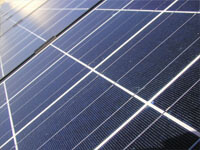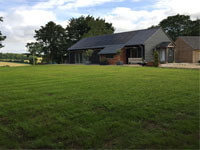Our technical guide to planning permission requirements for solar panels

Planning Permission for Solar Panels
Do I need planning permission for Solar Panels?
Householders can normally make minor alterations to their houses without requiring planning permission. This is called “Permitted development.”
Installation of solar panels on residential buildings is generally considered to be permitted development, with no need to apply for planning permission. There are some limits and conditions which must be met to benefit from these rights though, and on this page we’ll be referring to guidance on the Planning Portal.
Planning permission is usually not needed
Some space requirements around roof edges
Additional rules for conservation areas and listed buildings
Different criteria for commercial buildings
Installation considerations
The main considerations for installers and for customers wishing to install solar panels on their homes are:
“Panels should not be installed above the highest part of the roof (excluding the chimney)”
This is easily achievable and standard practice for pitched or sloping roofs. Solar panel design engineers will design solar systems to fit on the roof and not extend beyond the ridge.
Micro-Generation Certification Scheme (MCS) recommends leaving a 300 – 400 mm gap between the top of the array and the ridge of the roof. This is to avoid putting pressure on your roof and panels from wind, so there are multiple reasons to conform to this guidance.
“[Solar panels] should project no more than 200mm from the roof slope or wall surface.”
Again, for sloping roofs it is standard practice to install panels under 200mm from the slope of the roof. Solar mounting frames used to attach solar panels to pitched roofs are low profile and the panels won’t project more than 200mm from the roof slope.

Solar panels mounted on a residential roof sit less than 200mm above the surface.
Do I need planning permission to install solar panels on a flat roof?

Solar panels on a flat roof with a low angle to conform to permitted development (less than 200mm from the plane of the roof).
Since the regulation change at the end of 2023, planning permission is not needed for flat roofs. As the planning portal explains:
“On a flat roof the highest part of the solar PV equipment cannot be more than 600mm higher than the highest part of the roof (excluding chimney).”
All of our flat roof mounting options will meet this requirement.
Planning Permission for solar on commercial buildings
There are a different set of rules for planning permission on commercial buildings. The height above the roof requirement of 200mm still applies, and standard mounting systems will all comply with this.
At the edges, base and apex of the roof a gap of 1m must be left. For large metal roofs, this requirement is sensible from a wind-loading perspective and to allow space for scaffold edge protection during the build and a safe working environment.
For smaller tiled roofs on commercial properties, such as you might find on schools or offices, leaving 1m perimeter can limit the installed capacity of solar panels, and make systems look a little peculiar. In these cases, we’d recommend an informal conversation with the planning department.

Commercial solar PV installation showing 1m boundary between panels and the roof edge.
Can I fit solar panels while getting a loft conversion?

Solar Panels fitted to a loft conversion roof. In-roof panels on the pitched roof section and mechanically fixed panels on the flat roof section.
The short answer is yes. Fitting solar at the same time as getting a loft conversion makes a lot of sense. It can’t hurt to include the solar panels on the planning application for a loft conversion, if you think you might want solar panels.
Loft conversions often include an installation of a new, rear dormer roof to increase headspace in the loft room and flat, dormer roofs are a great place to fit solar panels as they are normally hidden from the street at the back off the house. It’s also possible to fit panels on the front sloping section of roof at the same time.
If your roof is getting re-slated or tiled, you can save on slate by fitting in-roof solar panels.
Do I need planning permission for solar panels in conservation areas?
Many people assume that you’ll need planning permission to install solar panels in conservation areas. However, that’s not always the case.
The only difference to permitted development in conservation areas is:
“If your property is in a conservation area, or in a World Heritage Site, panels must not be fitted to a wall which fronts a highway.”
Solar panels fitted to roofs facing the street are still considered permitted development in most cases. Panels fitted to a wall which fronts a highway in a conservation area are not Permitted Development.

Wall mounted solar panels are not permmitted development in a conservation area.
Do I need planning permission if my building is listed?
Yes. If your property is listed, you will need planning permission and listed building consent.
As the guidance states:
“The panels must not be installed on a building that is within the grounds of a listed building or on a site designated as a scheduled monument.”
Normally, listed buildings are sensitive and will require particular care in designing and applying for planning and listed building consent. We’d recommend contacting an architect or planning consultant if your house is listed, as they will give you the best chance of getting approval.
There are a number of design considerations that can help here. Using all-black panels, instead of conventional modules with a silver frame and white backing, will help your project be seen more favourably from a conservation perspective.
We have installed on listed buildings many times, including Salisbury Cathedral and royal palaces.
What is an Article 4 Direction and do I need Planning Permission if my area has an “article 4” in place?
Article 4 Directions are fairly rare and exist in parts of some conservation areas. They are used as a way of protecting the character and appearance of some areas where there is a particular historical or cultural significance.
An article 4 direction limits the works that can be carried out under Permitted Development and if you live in an area where there is an article 4 in place you probably already know about it! You can check by visiting your local council website or calling the planning department.
Article 4’s often only apply to basement conversions or converting your house to an HMO (House of Multiple Occupation) and if an Article 4 is in place, it may mean that you need to apply for planning permission to fit solar. If so, we’d recommend contacting a planning consultant or architect as the application is likely to be sensitive and they will give you the best chance of success.

Do I need planning permission for ground mount solar panels?

Ground mounted solar panels require planning permission in most cases.
The short answer is yes, you do need planning permission for most ground mount solar arrays.
Very small arrays are considered permitted development, but “the size of the array should be no more than 9 square metres or 3m wide by 3m deep”. In practice this would only allow an array of 4-5 panels, which would not be economically worth it in most cases.
An alternative is to install a moveable ballasted system such as this one, which can be considered a temporary structure and therefore doesn’t need planning permission.
Some customers have been happy to submit the application themselves while others prefer to use an architect or planning consultant.
If you are not already in touch with an architect or planning consultant, we can recommend one to you.
Find Out More …
Solar for Businesses
How we work with businesses to help them reduce their carbon emissions.






